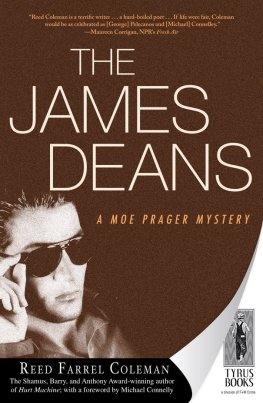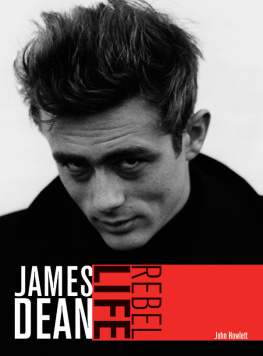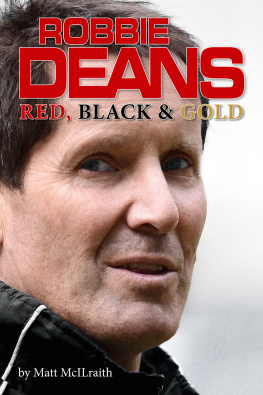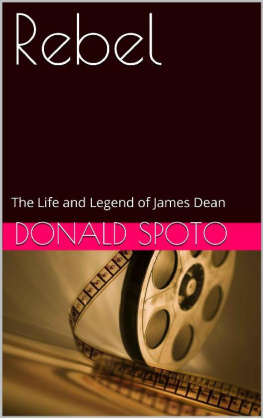The Death of James Dean
The Death of James Dean
Warren Newton Beath

This book is dedicated
to Zenna Lee Beath
There are no accidents
Copyright 1986 by Warren Beath
All rights reserved. No part of this book may be reproduced in
any form or by any electronic or mechanical means, including
information storage and retrieval systems, without permission in
writing from the publisher, except by a reviewer, who may quote
brief passages in a review.
Published simultaneously in Canada
Printed in the United States of America
Library of Congress Cataloging-in-Publication Data
Beath, Warren, 1951
The death of James Dean.
I. Dean, James 19311955Death and burial.
2. Moving-picture actors and actressesUnited States
Biography. I. Title.
PN2287.D33B4 1986 791.430280924 [B] 86-45520
eBook ISBN-13: 978-0-8021-9611-8
Grove Press
841 Broadway
New York, NY 10003
For what is your life? It is even a vapor, that appeareth for a little time and then vanisheth away.
The Book of James
When are you ghouls going to eat?
Anonymous Hollywood reporter
Acknowledgements
Thanks to the following people: Charles Adams, Albert Call, Roger Cannon, Jack Douglas, Clifford Hord, Phil Hord, Ruth Hord, O. V. Hunter, Kenneth Kendall, Larry F. Minor, Ron Nelson, Maila Nurmi, John W. Stander, Ernie Tripke, and Bill Hickman.
I am also indebted to Marian Terstegge of the Tulare County Library, and the research staffs of the Bakersfield, San Luis Obispo, Salinas, and Pomona libraries. Jim Hines of the San Luis Obispo Coroners Office was helpful in disclosing file no. 116 containing the accident reports, plus related unpublished documents, concerning the death of James Dean. Friedhelm Baas, Erster Polizeihauptkommissar of Kupferzell, Germany, contributed invaluable information which completed the story of the last years and the death of Rolf Weutherich. Alice Shafer translated the material.
Special thanks to Roger Eastman and Julian Bach, and to Edward Rae Paine and Geraldine Gleffe, my mother, who were very supportive.
The Death of James Dean
Chapter 1
There is a telephone pole in California. It stands by a highway on a grassy plain twenty-eight miles north-east of Paso Robles, which is itself two hundred miles north up the coast from Los Angeles on Highway 101. An aluminium plaque is hammered into the wood with heavy nails. It has become yellowed and rusted with rain and wind. It depicts movie idol James Dean at the wheel of the low-slung and predatory racing car he had nicknamed The Little Bastard. Dean is wearing glasses, his head turned sharply to profile. The picture was taken by his uncle on the day Dean died, 30 September 1955. The wreck was at the intersection to the east.
The intersection as it existed at the time of the accident was obliterated in 1959 when the highway was widened and rechannelled with a safety island. In the early 1970s, mechanical pole lights were added to illuminate the intersection at night. Warning lights were strung overhead to wink an ominous yellow. On the road surface, in the middle of the safety lane, a group of self-styled Dadaist artists from Union City, disguised as surveyors, painted a four-colour portrait of Dean on his birthday in February 1982. He would have been fifty-two years old. The rainy months and the black scrubbing of tyres have left it a mere smoky smudge.
A mile to the west, around a curve in the highway, is the sign CHOLAME. This is the Cholame Valley. That is Cholame Creek. Those are the Cholame Hills. The name has its origin with the long-dead Chumash, the Indians who lived on this land before there was a highway and telephone poles. Past the sign, there is a grove of trees to the left where a school once stood. On the right, set off the highway, is a tiny 10 ft by 7 ft ramshackle U.S. Post Office. The little building has been there since 1935, when it was the quarters for the foreman of the road crew building the highway.
Near the highway is a tree. Snaked around it is a gleaming chromium sculpture as striking and anomalous as a spaceship settled in the desert in a 1950s horror movie. It was built and brought here from Japan in 1977 by a rich Japanese businessman named Seita Ohnishi at a cost of $15,000.
JAMES DEAN
February 8 1931 September 30 1955 p.m. 5:59
There is the symbol of infinity. The mirror surface of the steel reflects the intersection where it happened.
On Saturday, 26 September 1981, Ohnishi returns to his monument from Japan. He has brought his interpreter. The occasion is the advent of the twenty-sixth anniversary of Deans death. He is met by Roger Cannon of Carmel, the founder of the James Dean Memorial Car Rally. Cannon presents him with a complimentary rally map and route guide. Each year, participating Dean fans retrace the route their hero took from Los Angeles on his last day.
Around 2 p.m., twenty hot-rodders pull up. They are members of Will ONeils vintage car club. Led by ONeil, they, too, caravan every year from Van Nuys on the death route to meet at the cenotaph. The two rallies do not celebrate one anothers arrival. The ONeil club is more car-orientated, and the day is largely an excuse to get out and show off their restored machines. The Dean purists of Rogers rally tend to look down on them.
The 1949 Mercs and 1950 Fords clustered around the monument give it a festive air. Ohnishi has brought some Japanese lanterns, each bearing a letter. Once in place, festooned across the sculpture with coloured bulbs, they spell out JAMES DEAN FOREVER.
Ohnishi, who speaks no English, hands out small cards which read:
A TRIBUTE TO JAMES DEAN
His name was James Byron Dean. He was an actor. He died in an automobile accident just before sunset on September 30, 1955 at the intersection 800 meters east of this tree, which has long been called the tree of heaven. He was only twenty-four years old.
Aside from appearing in several Broadway plays, he starred in just three motion pictures before he died: EAST OF EDEN, REBEL WITHOUT A CAUSE, and GIANT. Only one, EAST OF EDEN, had been released prior to his death. Yet, before he was in his grave, he was already a myth. With the subsequent release of the other two pictures, he became a legend.
It is fitting tribute to his brilliance as an actor that his movies continue to be shown throughout the world even today. Every day somewhere, in a cinema or on television, his image lives on, an inspiration to millions everywhere, young and old alike. His fame is international; his impact, historic. He was the brief, living manifestation of a new era, the persona to which a whole generation pinned its hopes for a better tomorrow. He was more than merely a movie star. He was, and remains, a symbol.
I am only one of many who feel strongly that James Dean should not be forgotten. There are some things, like the hatred that accompanies war, that are best forgotten. There are others, like the love inspired by this young actor, that should be preserved for all time.
Yet this monument is not intended to be merely a tribute to James Dean. It is also meant to be a reaffirmation of the value of all human life. That is why, in accordance with an old Japanese custom, this marker has been placed at the site of the accident that took his life, to serve both as a memorial to the young man I so admired and a reminder to all that life is a precious gift to be preserved at all costs.
I have at long last been able to realize my dream. Having transported this monument across the Pacific Ocean from Japan where it was designed and made, I have had it erected on this spot and dedicated to this day. For me, there is no greater happiness. It is but a small token of the appreciation I feel for all that I have learned from America.
Next page








